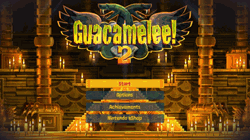 Yo, white guy here, and I’m going to talk about cultural appropriation regarding a country/culture that is the whipping boy of an entire American political party. Oh, and we’re also going to explore a distinctly American vacation destination, too. And if we have time after all that, there will probably be something about a videogame in here.
Yo, white guy here, and I’m going to talk about cultural appropriation regarding a country/culture that is the whipping boy of an entire American political party. Oh, and we’re also going to explore a distinctly American vacation destination, too. And if we have time after all that, there will probably be something about a videogame in here.
Just remember: you’re always a wiener when you talk about Mexico, amigos.
For those of you that have not looked at a map lately, Mexico is one of two countries that border on the United States. And, let’s be clear on what has apparently happened here, it is “America’s” “oh no you’re bringing down the property values” neighbor. Canada is always the example of where United States citizens will flee when their chosen candidate doesn’t win an election, and Mexico is always portrayed as the crime capital of the continent. If someone is “going to Mexico” in fiction, they are inevitably doing it to escape the consequences of some wrongdoing, or to commit all new wrongdoings. Or, to put it another way, nobody ever talks about being kidnapped by a drug kingpin in Ontario. And, to be absolutely clear about my position on this nonsense: this is bullshit. You want to talk about a dangerous place in North America, USA? Have you seen yourself lately? Do you know how many school shootings have happened since I started writing this paragraph? Do you know how many of those big, scary drugs were passed around just in a local Wal-Mart parking lot? You want to build a wall, you nitwits? Maybe you could “build a wall” around those Fox News pundits that seem to be suggesting life-saving vaccines are causing boneitis!?
And the kicker of all of this? You can apparently run two separate presidential campaigns on the concept of Hispanophobia, yet one of the chief vacation destinations for “Americans” is Mexico. Look! There goes Ted Cruz now! Mexico is unquestionably one of the USA’s prime spots for relaxation, and the sheer number of all-inclusive resorts available across the country are a testament to how many (literal) dollars are spent in a country filled with people that a political party wants to “keep out”. The hypocrisy is palpable, and the $475,000,000,000 Americans spend a year on Mexican vacations (2016 data) is proof enough that it is more than a handful of Democrats that enjoy the company of Mexicans.
But if you’re looking for a Mexican vacation, and don’t want to deal with the actual country of Mexico, have you considered… South Carolina?
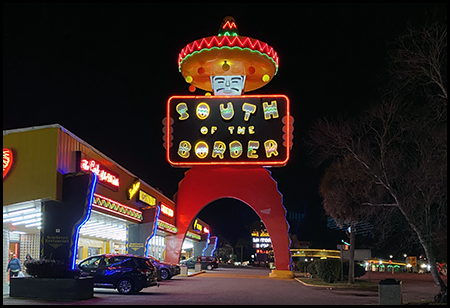
South of the Border is a roadside attraction in South Carolina, USA. It is just past the North Carolina/South Carolina border on I-95, thus, ya know, “south of the border”. South of the Border is a place that has grown from a simple beer stand to a “resort” that now proudly features five restaurants, seven gift shops, 300-foot-tall observation tower, two pools, campground, reptile habitat, and a giant gorilla wearing an ill-fitting t-shirt. And how has South of the Border seen such unprecedented success over the years? By exploiting arbitrary laws! When South of the Border started as little more than a bar in 1949, it was manipulating the fact that the local North Carolina counties were currently dry. And when local prohibition laws lightened up, fireworks were still illegal in many states. But not South Carolina! So people from all over traipsed over the border to the closest fireworks depot available. Even today, when many “safe” fireworks are available across the country, South of the Border utilizes the more generous laws of S.C. to sell some fireworks sets that are… well, they’re not exactly guaranteed to blow off a limb, but the advertising does seem to imply that as a distinct possibility. And through South of the Border’s meteoric rise to fame, it maintained the “joke” of its own name, by importing Mexican “trinkets” and proudly displaying a vaguely Mexican motif around the grounds.
And, to be absolutely clear, I love the place. Bury me in a coffin with zigzagged red and yellow stripes that light up every time someone gets within 40 feet of the thing, because I love this level of kitsch. Nigh everything at S.O.B. is gigantic and garish. There is more neon pumping through this quasi-city than Las Vegas. There are haphazardly distributed statues of dinosaurs, hats, and dinosaurs wearing hats. Gift shops sell an equal number of children’s toys and “the world’s largest condom”. You can eat at a steakhouse or “Porky’s Truck Stop”. There are marginally abandoned rides for the kids, and you may get the distinct impression that there might be a “monster” running around that will eventually be thwarted by some meddling kids. There is “The Sombrero Restaurant”, and, inexplicably, it has nothing to do with the restaurant that is like 100 yards away and shaped like a giant sombrero. There are “Year 2000” mugs on sale in the year 2021…

They’re vintage! Oh, and there’s the official mascot of South of the Border, Pedro.
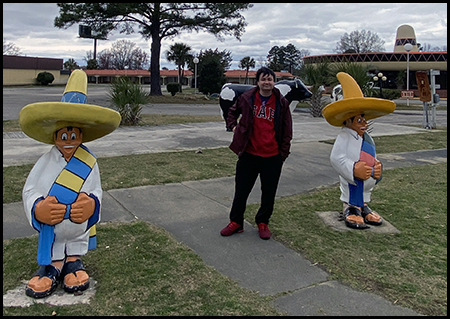
This Goggle Bob photobombed these poor Pedros
Pedro has… issues.
Pedro is the “face” of South of the Border. He’s gone through a few permutations through the years (who hasn’t?), but Pedro has consistently been the most prominent piece of South of the Border iconography for decades. And where did Pedro originate? Well, let’s check the ol’ South of the Border official website for some information…
“Mr. Schafer [founder of South of the Border] went to Mexico to establish import connections and met two young men. He helped them get admitted to the United States, and they went to work at the motel office as bellboys for several years. People started calling them Pedro and Pancho, and eventually just Pedro.”
Let’s… let’s just sift through the… implications of this story, and the way it is told today. First of all, “Pedro and Pancho” are not recounted by their real names, simply Pedro and Pancho. Dudes inspired the most recognizable part of South of the Border, but they don’t rank high enough to earn a credit like Mr. Schafer. Second, the whole “Pedro and Pancho” thing is a stereotype bordering on slur, right? Did a little research here, and it appears to be something that pops up in On the Road by Jack Kerouac, a book that compared Native Mexican “Indians” to “the Pedros and Panchos of silly civilized American lore”. As the tone in that passage seems to indicate that Kerouac is mocking the stereotype, the phrase was probably already widely used in the 50’s. Regardless of whether it was one of those “cultural osmosis” situations or a stereotype that arose from too many episodes of The Cisco Kid, I’m willing to bet that the original “Pedro and Pacho” were not too excited about being renamed for their American jobs. And then they were just both rechristened “Pedro”? Like remembering two separate names was too hard? Or just “telling apart two Mexicans” was going to be a problem for too many people?! And somehow this wholesome story is considered safe enough that it is not only publicly listed on South of the Border’s website, but you can also get it on a t-shirt!?!

And as much as I love South of the Border, this serves as an uneasy reminder that South of the Border is promoting the general concept of Mexico while doing nothing to give back to actual Mexico. It is not like 70% of every sale needs to assist a random family in Mexico City (though that wouldn’t be a bad idea), but this is still a situation wherein a loose definition of Mexican Culture is being adapted, slapped on a glowing billboard, and then used to sell fireworks. It is nice that South of the Border is unambiguously supporting Mexico with its theming (as of 2021, there were not any signs/merch that I could find that were promoting “keep them out” or alike), but it is still a story of white guys that reduced their Mexican workers to “they’re both Pedro”. In much the same way South of the Border grew as a business by exploiting border-based loopholes, this inextricable chunk of Americana also preyed on the general aesthetics of a Mexico its locals likely would never touch.
 And that (finally) brings us to today’s game, Guacamelee! 2. Here is a game about the “Mexiverse” that was made by real, live… Canadians. Huh.
And that (finally) brings us to today’s game, Guacamelee! 2. Here is a game about the “Mexiverse” that was made by real, live… Canadians. Huh.
Before we go any further, it must be stated that Guacamelee! 2 is an amazing videogame. And Guacamelee! (1) was, too! Which is good, because G!2 reuses an awful lot from its immediate ancestor. Nearly all of the special moves available to our favorite luchador are rehashes from the prior game, which very well could work poorly for a game that is just enough of a Metroidvania that it should know better. But, on the other hand, Juan always handled like a dream, mixing the simplicity of Smash Bros’ “direction + button” controls with movement and beat ‘em up challenges alike that are the ol’ “easy to learn, difficult to master” that makes up the best of videogames. So, yes, G!2 is a lot like G!1, but G!1 was amazing, so how are you supposed to improve on that? And the new challenges that are introduced, like drifting dimensional zones and various chicken powers, are welcome and well-explored. Did you like Guacamelee! (1)? Do you enjoy beat ‘em ups and/or Metroidvanias, like, at all? Guacamelee! 2 has you covered, and is one of the best entries in two different genres.
And, if you haven’t noticed from the screenshots and name, Guacamelee! 2 is Mexican as Infierno. And, given Guacamelee! 2’s general… levity with everything, it leads to a pretty obvious question: is this another South of the Border situation? Is this an affectionate parody, or a simple exploitation of a culture?
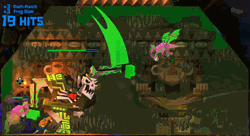 First of all, according to interviews, the Mexican theming of Guacamelee! (1) was not the origin of the game. The setting for Guacamelee! originated with one of Drinkbox’s animators, Augusto, and was only approved after generating some concept art. And, once again, we are talking about a flock of Canadians here. That is kind of an auspicious start to a game that would eventually feature “The Mexiverse”. And an awful lot of what is featured in both Guacamelee! titles focus on two things: Día de los Muertos and Luchadores. And, while these are two indivisible pieces of Mexican culture, it is also possible to showcase their basic iconography without any more than a shallow reading of the source material. Everybody likes ornate skeletons, right? And wrestlers in funny masks? Throw in some dudes with a decent tan, and that’s Mexico, baby! Let’s get those sweet Coco bucks!
First of all, according to interviews, the Mexican theming of Guacamelee! (1) was not the origin of the game. The setting for Guacamelee! originated with one of Drinkbox’s animators, Augusto, and was only approved after generating some concept art. And, once again, we are talking about a flock of Canadians here. That is kind of an auspicious start to a game that would eventually feature “The Mexiverse”. And an awful lot of what is featured in both Guacamelee! titles focus on two things: Día de los Muertos and Luchadores. And, while these are two indivisible pieces of Mexican culture, it is also possible to showcase their basic iconography without any more than a shallow reading of the source material. Everybody likes ornate skeletons, right? And wrestlers in funny masks? Throw in some dudes with a decent tan, and that’s Mexico, baby! Let’s get those sweet Coco bucks!
But there is more to Guacamelee! 2 than a few Cempasúchil petals sprinkled around. In an effort to not just be some random white guy talking about a culture he only has the most tangential relation to (technically I have pre-New Mexico statehood “New Mexican” blood in these veins, and all that really means is that there is an ancient recipe for fajitas in my family cook book [oddly, this is not a joke]), I consulted friend-of-Gogglebob.com Zef, a person that is very familiar with Mexico (almost like he lived there for years of his life or something). Here is Zef’s (partially paraphrased) take on Guacamelee!:
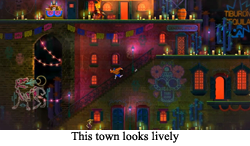 “[Guacamelee! has the kind of references that come from] knowing the culture and living in it, and appreciating cultural in-jokes that most people outside Mexico will probably never get, but which have Mexicans in stitches. Instead of appropriating something from a culture for the benefit of, ahem, a foreign audience, it takes the native audience aside and makes a private joke just for them.
“[Guacamelee! has the kind of references that come from] knowing the culture and living in it, and appreciating cultural in-jokes that most people outside Mexico will probably never get, but which have Mexicans in stitches. Instead of appropriating something from a culture for the benefit of, ahem, a foreign audience, it takes the native audience aside and makes a private joke just for them.
This is very similar to what it does with gaming culture as a whole, as Guacamelee is also [in]famous for all of its videogame memes and injokes. When the most difficult, most brutal puzzle-platforming gauntlet rewards you with the same message as the Special Zone of Super Mario World, you know that was done with intent, and that while some people may need to look it up, those who remember it will gape and then laugh at it. And when it goes and has you climbing onto giant feathered snakes that weave up and down and left and right, deftly combining the iconic ‘Kukulkan descends the pyramid staircase’ Spring Equinox event in Chichen-Itza with the Snake level from Battletoads, that’s like a triple-layer pun and I’m all here for it.
Another important thing that often gets overlooked is that, while the games are full of stereotypes, and ‘benign racism’ is definitely a thing in many media productions, the Guac games go a long way towards diluting those same stereotypes by providing a very diverse cast of characters–protagonists, villains, or even just NPCs. As a concrete example, there’s definitely ‘lazy Mexican in a sarape’ background characters, but because of that variety of depictions, the audience can read them as lazy because that’s what the individual character is, as opposed to the ethnicity or the culture. If anything, given the roles they fill and the circumstances of narrative development, I’d say that they’re fantasy stereotypes first and foremost, and Mexican stereotypes second.
 There’s also a certain jai ne se quoi in the way characters speak, their mannerisms and word choice, that is distinctly ESL (and this, coming from an English-as-Second-Language person). The script may have been originally penned by a native English-speaking Canadian, I don’t have the credits with me, but it was tweaked and adjusted well enough that, as weird as it may sound, it feels localized from Spanish speech.
There’s also a certain jai ne se quoi in the way characters speak, their mannerisms and word choice, that is distinctly ESL (and this, coming from an English-as-Second-Language person). The script may have been originally penned by a native English-speaking Canadian, I don’t have the credits with me, but it was tweaked and adjusted well enough that, as weird as it may sound, it feels localized from Spanish speech.
Now, of course, Guacamelee does maintain certain stereotypes I’d like to see diluted, myself. Both games take place in ‘culturally distinct’ locations such as rural villages, jungles, deserts, and Pre-Columbian-style temples. Which is all well and good, Mesoamerican civilizations need their day in the sun and it’s nice to show colorful and vibrant villages as opposed to the dusty shantytown stereotype (and thank god it isn’t all just Western-inspired deserts and cacti and sombreros everywhere). But it would be wonderful if Guac 3 had, say, ‘concrete jungle’ locales where you had to navigate a big city with Colonial-era architecture alongside modern glass towers and concrete apartment buildings. Just as there’s variety in the depictions of rural villagers and luchadores, it’d be nice if it could show diversity in many other areas of Mexican culture and not just Day of the Dead. The premise certainly supports it, as AAA Lucha Libre is famous and popular at all strata of Mex society.”
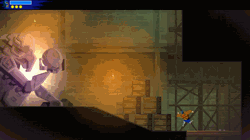 Thank you for that comprehensive explanation, Zef! And, for the record, Zef would like it to be said that this is just the opinion of one Mex. However, let it also be said that Gogglebob.com officially promotes the opinion of anyone that enjoys Guacamelee! 2.
Thank you for that comprehensive explanation, Zef! And, for the record, Zef would like it to be said that this is just the opinion of one Mex. However, let it also be said that Gogglebob.com officially promotes the opinion of anyone that enjoys Guacamelee! 2.
So what does this all mean? Is Guacamelee! 2 another game that is destined to go down in history as a Mexi-leech that thinks “they’re all Pedro”, or is it a shining bastion of Mexican culture in a medium that barely remembers there is anything other than Japan and “America”? Well, as usual, it is not something that is that cut and dry. But one thing is for certain: Guacamelee! 2 is a damn fine videogame, and it contains a host of loving nods to Mexico that are a lot more interesting than a dude in a sombrero.
And, hey, after everything from the last… centuries… Mexico deserves at least that.
FGC #579 Guacamelee! 2
- System: Playstation 4, Xbox One, PC, and Nintendo Switch. Personally, I prefer the Switch version, as you can play the “important” parts on the TV, and futz around with the more challenging areas while in handheld mode/watching TV.
- Number of players: Four! You can have four different players at a time! That sounds really fun! And absolutely not something I’m ever going to be able to get a group together to actually do! I’ll be more likely to organize a road trip to South of the Border first…
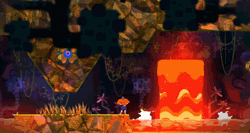 Speaking of Challenge Levels: Like in G!1, G!2 has a number of areas that really test the valor of your luchadore. And, like in the original, I am forced to complete every one of these challenges, as I kind of live for that nonsense. Luckily, the respawn rate for these challenges (and the rest of the game, for that matter) is tough but fair, and no challenge seems too far outside the realm of possibility. Even if it did take like two hours for me to get through that chicken crucible…
Speaking of Challenge Levels: Like in G!1, G!2 has a number of areas that really test the valor of your luchadore. And, like in the original, I am forced to complete every one of these challenges, as I kind of live for that nonsense. Luckily, the respawn rate for these challenges (and the rest of the game, for that matter) is tough but fair, and no challenge seems too far outside the realm of possibility. Even if it did take like two hours for me to get through that chicken crucible…- Weird Connections: Speaking of, the existence of “The Crucible” and way too many chicken jokes really reminds of Fable 2. Whatever happened to that franchise? … No, I’m not actually asking that question.
- Favorite Mexiverse Timeline: The conceit of the Mexiverse at large allows for Juan to visit a number of videogame parody areas, like “Limbo”, a grindy JRPG universe, or a whole timeline apparently dedicated to being a terrible cell phone gacha. That said, the best timeline is one where you get to beat up a car not once, but twice. Thank you, Street Fighter, for giving us the iconic struggle of man versus random vehicle they just happened to encounter. And, hey, thanks again to Zef for reminding us that the featured car is not remotely random, but another “Mexican reference”. Once again turning my mic over to the expert… “The classic Volkswagen Beetle used to be ubiquitous on Mexican roads, as it was cheap, easy to get parts for and repair, and efficient as a taxi cab for its size and ease of driving. So, it received the moniker of “Volchito” (or, to some, Vocho). That’s the kind of detail that comes from knowing the culture and living in it, and appreciating cultural in-jokes that most people outside Mexico will probably never get, but which have Mexicans in stitches.”
- He is The Juan: There is much made of the plot with Juan being the last living Juan in the Mexiverse. But… is that the joke? Like, Juan died at the start of Guacamelee!, and I’m moderately certain he is dead again about 5% of the way into Guacamelee! 2. Dude basically lives in the realm of the dead, so I don’t see the big deal about sticking a dead Juan’s skull on any random body. He’s a resilient guy. He’ll get used to it.
- Favorite Costume: Hey, the Switch version came with all the DLC. Guess I’ll dress up as Flame Face, because I like racking up the combo meter and having a flaming head. It worked for Nicolas Cage!
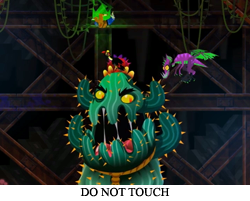 Favorite Boss: Zope y Cactuardo combines two things I love in a game: a boss that is using “your” moves against you, and a giant cactus. Wait, no. The giant cactus is good because it reinforces how Juan really “only” punches and grapples, so a boss that is too spikey to touch is completely omnipotent. Please, nobody give Juan a gun! It will mess up his mojo!
Favorite Boss: Zope y Cactuardo combines two things I love in a game: a boss that is using “your” moves against you, and a giant cactus. Wait, no. The giant cactus is good because it reinforces how Juan really “only” punches and grapples, so a boss that is too spikey to touch is completely omnipotent. Please, nobody give Juan a gun! It will mess up his mojo!- Did you know? Drinkbox has claimed they created new moves for Juan, but went back to the originals after determining the OG moves were more intuitive. Just as well, performing a perfect headbutt still feels satisfying when destroying a hundred skeletons.
- Did you know (South of the Border Edition)? If you think I’m the only person that has ever taken notice of good ol’ South of the Border, please refer to this frame from Season 6 of The Simpsons.
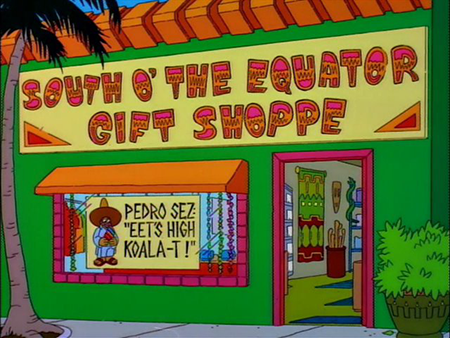
Yes, in 1995, Bart vs. Australia was already parodying of our friend in the sombrero. The Simpsons did it, indeed. - Would I play again: This game is super fun. I will play it again. That’s it. That’s the answer. I love this game.
What’s next? Random ROB has chosen… Mega Man Powered Up for the Sony PSP! Mega is all powered up and ready to go! And he got really short for some reason, too! Please look forward to it!
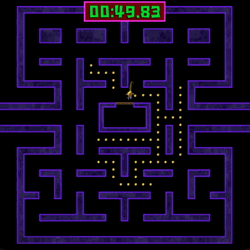
No no. This isn’t right at all.
[…] to demolish. Aero Fighters 2 also tries to be “real” by including legitimate locations (Mexico is a real place!) and featuring their attendant national landmarks. Or, put another way, yes, you can get powerups […]
[…] it was time for the long car ride home, and the best a wee Goggle Bob could hope for was a stop at South of the Border. This pattern continued into my teen years, when it ceased thanks to a combination of those great […]
[…] stuff” a lot more than anything traditional. I am absolutely the person that would choose South of the Border over Disney World, and I am less interested in the Super Bowl than Netflix repurposing 1988 manga […]